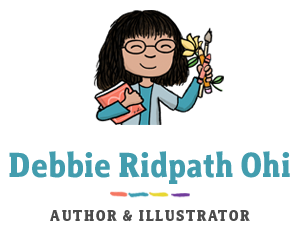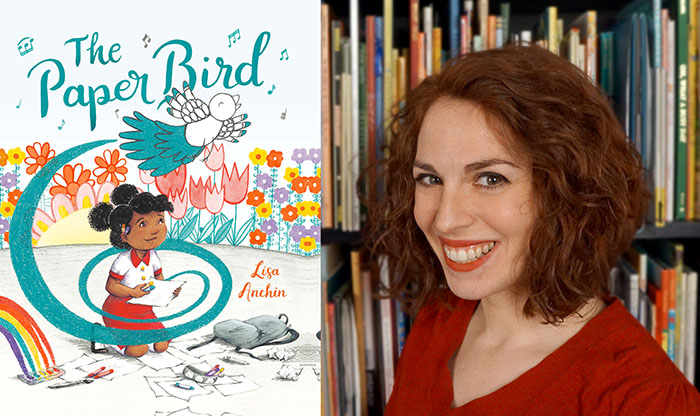
Lisa Anchin (she/her) is a Brooklyn based writer and illustrator who took a long circuitous route to publication. She is often holed up in her studio stringing words together and doodling, but she also loves meeting other kidlit folks and volunteers as the Illustration Coordinator for SCBWI’s Metro NY Chapter. She is the author/illustrator of THE LITTLE GREEN GIRL (Dial Books for Young Readers 2019) and THE PAPER BIRD (Dial Books for Young Readers 2022) and the illustrator of THE POLIO PIONEER (Knopf Books for Young Readers 2020), a Sydney Taylor 2021 Notable Book. She lives with her husband and two young daughters. You can find out more about Lisa at LisaAnchin.com, Twitter and Instagram.
Upcoming events:
Sat. April 23rd at 10:30-12:30 pm ET – Draw For Ukraine fundraising event at Books Are Magic (Brooklyn, NY)

Synopsis of THE PAPER BIRD (Dial Books):
There once was a time when all the colors, from midsummer blue to sunrise orange, lived at the tip of Annie’s fingers…
But when her classmates’ sidelong glances cause Annie to notice all the tiny flaws in her art, her colorful creative spark fades–quite literally–to gray. With lyrical prose and eye-catching illustration author-artist Lisa Anchin shows readers how to find the beauty in imperfections and celebrate the joy of creation for creations’ sake.
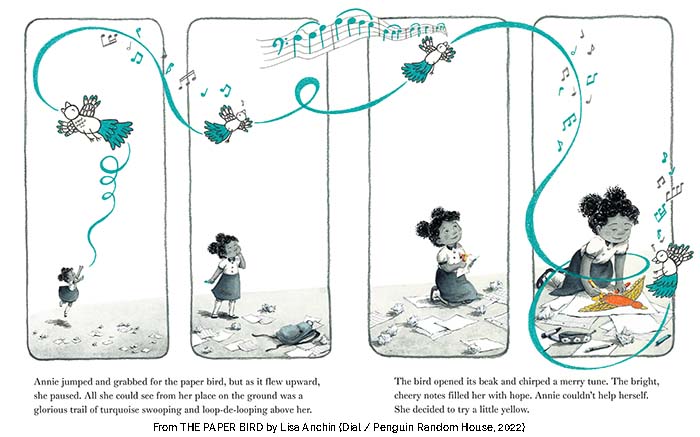
Q. What inspired you to create THE PAPER BIRD?
THE PAPER BIRD started out as a very different story, with nary a bird in sight. It was originally titled THE PAPER WOODS, and the central theme was about being overscheduled and too busy to do the things you love. That particular version of the story was very much inspired by what I was going through at that moment. However, no matter what I did, the story never quite worked, and I set it aside. When I next tackled a revision, I was in a doubtful place about my work, and the story shifted to focus on the cycle of doubt that we all feel at times. Annie’s story evolved and, in doing so, became somewhat of a reflection of my own fears and doubts in art making.
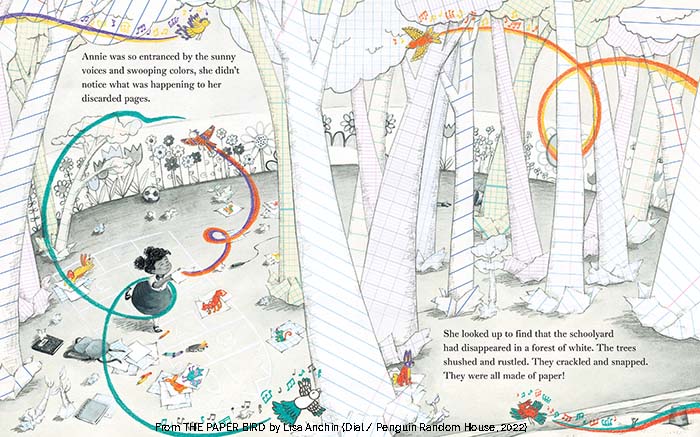
For me, the doubts are internal, but in Annie’s case, her doubts are sparked by external voices, those of her classmates. Their voices begin to overshadow what she knows about herself and what’s in her heart. The blank page in front of her becomes intimidating and overwhelming. At the time, I had just begun a daily sketch project, trying to push through my own fears and doubts to make something each day, even if I disliked the final drawing/image. The physical act of making more things helped me regain my own love of art-making, and Annie has a similar experience during her magical adventure. She draws pages and pages of birds, creatures, and the paper woods, and through the act of drawing/painting during this magical adventure, she learns to find the beauty in her imperfect drawings and learns to find the joy in creating art purely for herself.
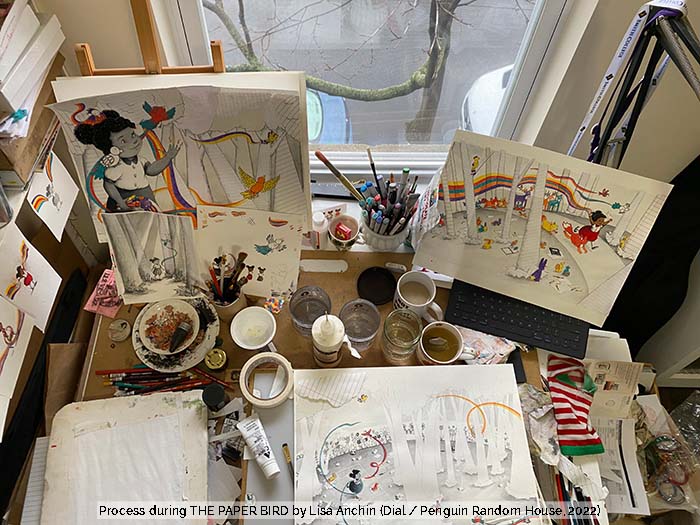
Above: “A shot of my messy desk while working on the finals.”
Q. What was the journey to publication for this book? How did it get acquired by your publisher?
THE PAPER BIRD took a bit over seven years and seventeen drafts/dummies from first idea to published book. I had the idea for both this story and THE LITTLE GREEN GIRL, my first author-illustrated title, in 2014. Because I couldn’t quite crack this story story, I set it aside to focus on THE LITTLE GREEN GIRL.
Like most contracts, my contract for THE LITTLE GREEN GIRL at PRH had a “right of first refusal” clause, so we shared it with my editor who asked for a few changes before she’d consider acquiring it. My editor at Dial is brilliant and has a way of asking just the right questions to help steer you and your revisions in the right direction. I made a number of edits, and after I resubmit the dummy, my editor made an offer on the book. Before submission, I had done 10 different drafts and dummies, some with major changes, some with minor ones. After acquisition, my editor and I have a long, involved editing process, always for the benefit of the book, and I have seven separate drafts/dummies for THE PAPER BIRD post acquisition. Revising is the real work of book making.

Above image: “Before collaging the paper trees, I had to lay all of the individual pieces out to see what order would be best for gluing down the trunks and leaves to give the impression of space and depth.”
Q. What was the most challenging part during the creation of this book? How did you get through it?
THE PAPER BIRD is a pandemic book baby. It was acquired in 2019, and most of the work I did for the book happened during the height of the pandemic. I had also had a new baby three weeks before the quarantines and shutdowns began in 2020. The book was, as you can imagine, challenging to finish. Work happened in fits and starts, but everyone at Dial was very understanding. We were all navigating the early days of the pandemic together, and we did push the pub date of the book to make up for those early challenges.

Image above: “For each collage, I photographed the preliminary tree layout with my phone. Then I numbered the trees in markup, so I’d remember what order I’d need to glue them down in.”
There was also one illustration-specific challenge in making the book. My original concept for the book was a grayscale book with a few pops of color–only the turquoise, red, yellow, violet, and orange swooshes of Annie’s creativity–and I began making the final art for the book based on this concept. I painted that first set of finals with ink, using acryla-gouache and colored pencil for the colorful pops.
When I showed my editor and designer the first half dozen paintings, they thought the grayscale wasn’t doing enough in terms of storytelling and asked if I would consider illustrating the book in full color.
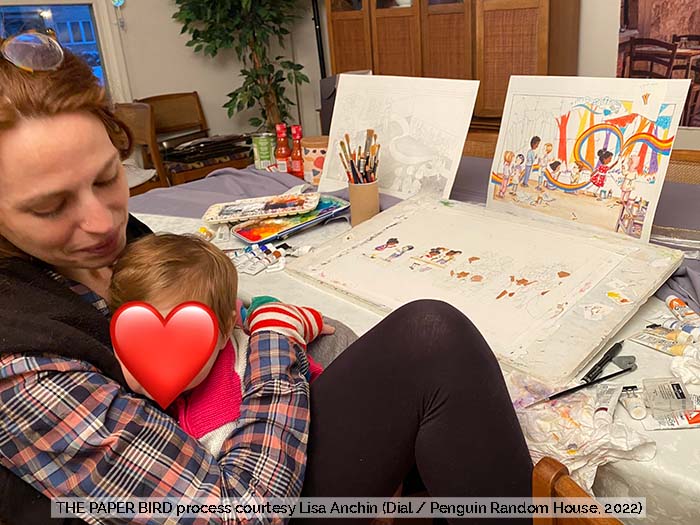
Above image: “Like everyone, we hunkered down during the pandemic. We live in an apartment, and with two small children–a then-two-year-old and a new baby–it was exhausting. We ended up spending a couple of months of the pandemic at my parents’ home, so we’d have more space (including a backyard) for the kids to run around. I used my parents’ dining room table as a work space, and in this photo, my husband had just brought me Mabel to nurse after her nap.”
I trust my team at Dial implicitly, and if they felt strongly enough to ask me to redo the art, I owed it, not only to my team, but also to the book itself, to give it a try. That being said, I’m human; it felt disheartening to have to redo final art. And in this case, even beyond the initial disappointment, I had never conceived of this book in full color. I didn’t have an overall palette. I didn’t even have an idea for what color Annie’s dress would be. It took a lot of hasty thumbnailing and color mapping and experimentation to figure it out. Ultimately, my team at Dial was 100% correct. It’s worth noting here that the publishing process is truly a collaborative one, and books are so much better for that collaboration. THE PAPER BIRD is much, much stronger for the targeted use of grayscale to illustrate Annie’s emotional journey, but I’m only human, and redoing the final art was a very hard thing to hear at the time.
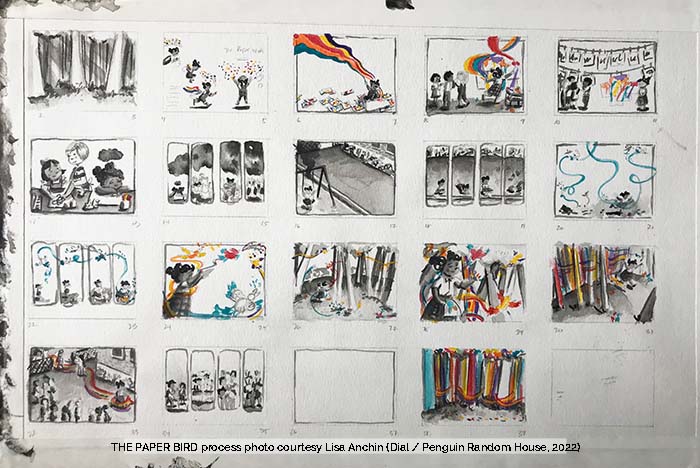
Image above: “…A full thumbnail map of my original concept for the black and white/limited color palette. The last spread isn’t drawn in because I had received notes on that sketch and was still revising it for my editor.”
Q. What do you hope young readers will take away from your book?
I hope that young readers will see that creativity comes from within. No matter what external voices–whether those from grown ups or other kids–say, we have to remember to listen to ourselves. I hope that readers find joy in making things solely for themselves. When she’s in the paper woods, Annie doesn’t need another character to tell her what she’s making is worthwhile. Art making shouldn’t be about external validation, but rather we should listen to our hearts and make something only we can make.
I hope my young readers learn to find not only the beauty in their own voices, but also in their mistakes and imperfections. Sometimes things don’t always look like how we want them to, especially on the first try. And in the same way that Annie sees and begins to appreciate the joyful turquoise of her bird, there’s always something worthwhile in each and every drawing or thing we make, even if it’s just the experience of making it.
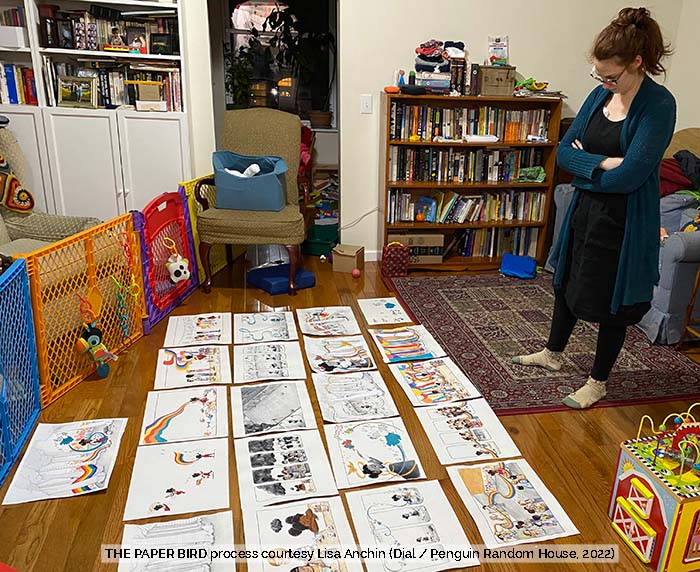
Image above: “We don’t have a wall big enough in the office/studio to hang all of the art, so I laid it all out on the floor in the living room (after my kids were in bed) in order to check for consistency. (Pandemic-life-with-small-children disaster of a living room pictured here in all its glory.)”
Q. What advice do you have for young writers and illustrators?
It can be hard to do, especially with so many social media platforms, but try not to compare yourself, your work, or your journey to anyone else’s. No one can tell the stories you tell or make the art you make, so trust yourself and your instincts. Do what feels true to you.
Likewise, each story takes the amount of time it takes, whether it’s a month, a year, or even seven years. It’s easy to look at someone else’s starshot story, and feel like it will never happen for you. But you don’t know what came before that. You don’t know how many late nights a writer/illustrator spent working and reworking something or how many drafts they did or how many unusable stories they have in their drawers that came before the one that made it. You can’t compare your path to publication to anyone else’s. You may not get that starshot experience, but if you really want this, you’ll get there. Just remember that it can take time.
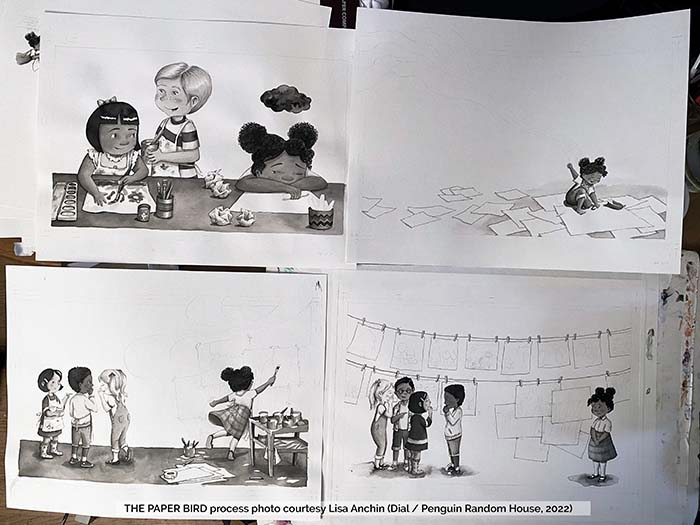
Image above: “Four of the final art spreads that I started painting in black ink before realizing I’d be making a full color book. No work ever goes to waste; even though we didn’t use these, the images make excellent value studies.”
Q. What are you excited about right now?
I’m excited to be drawing again. I know that sounds odd, but I haven’t been able to do much creative work this past year. I feel strongly about being transparent about this because these pandemic years have been really challenging for so many folks, especially parents. Between pandemic anxiety and parenting two very small children, finding time and energy to work has been difficult.
I only really started getting back to a regular art practice this past October. I love all of the drawing prompts during this month, and having a community of like-minded makers inspired me to get back to drawing on an almost daily basis. All of my “drawlloween” drawings are on my Instagram page. And even more recently, my oldest daughter has been home from preschool because of the pandemic, and we’ve been doing Wendy Mac’s We Draw Together classes, and it has been a wonderful refresh. My daughter adores it, and it gives me time to work in my sketchbook. It’s something we can share. Most of the drawing I’ve been doing is for two new projects that I can’t talk about yet, but both of which are really exciting.
You can see a replay of my Books Are Magic virtual story time and drawing event here.
See my Linktree for other upcoming events, including Draw For Ukraine on Sat. April 23rd (in-person event at Books Are Magic in Brooklyn, NY).
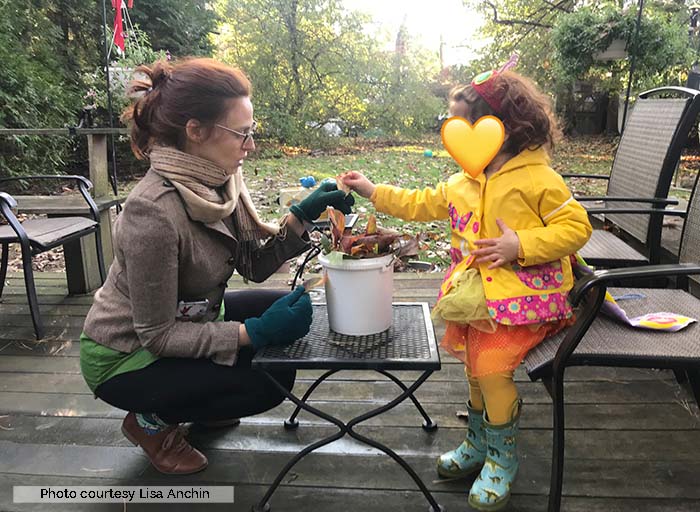
Image above: “It’s almost impossible to find a photo of me all by myself. For the past 4 years, 99.9% of the photos of me have one or both of my kids in them. We spend a lot of time as a family playing together. I think here we were making a nature stew, and Addie is wearing the Hungry Caterpillar butterfly costume I made for her for Halloween 2020. (wings, headband, and of course tutus)”
Also see other interviews with book creators as well as a compilation of advice for young writers and illustrators from interviewees.

